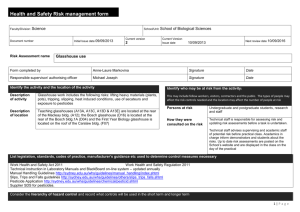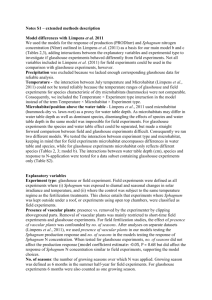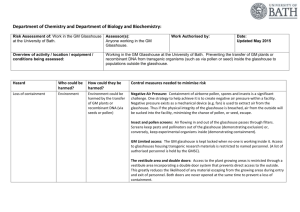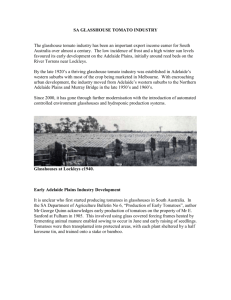Glasshouses_and_Frames
advertisement
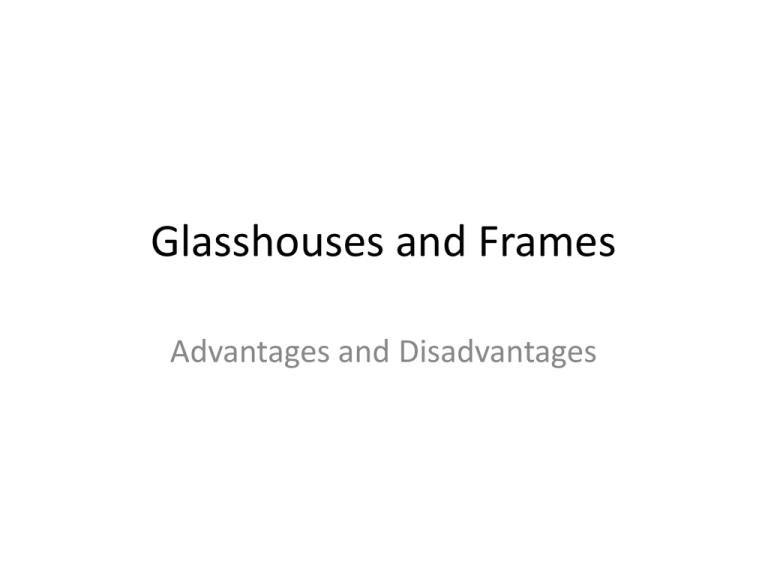
Glasshouses and Frames Advantages and Disadvantages Why have a glasshouse ? • To allow some gardening to continue irrespective of the weather conditions • A wider range of crops can be grown • Earlier fruit and vegetables can be obtained • Half hardy plants can be raised from seed • Large numbers of plants can be economically grown from seed Types of Glasshouses - Wood Advantages • Looks more at home in the garden setting • Better heat retention • Less condensation • Easier to put up hooks, staging and shelving Disadvantages. • Expensive • Requires treating with a preservative every few years Types of Glasshouses - Aluminium • Advantages. • Maintenance free • Light to handle when erecting • Thinner bars leading to slightly better light transmission • Disadvantages • Functional rather than beautiful Materials - Glass • Advantages. • Better light transmission • Better heat retention • More permanent • Disadvantages. • Expensive • Breakable Materials - Polycarbonate • Advantages. • Cheap (in the short term) • Easy to handle • Disadvantages. • Limited life of cover 3 – 5 years Shapes of Glasshouses Traditional span: • A good all-round glasshouse. The sides may be of wood, brick or glazed to the ground. The roof span gives a good headroom. Heat retention is better if it is not glazed to the ground. Dutch light • The sloping sides and glazing down to the bottom gives maximum light transmission and is good for crops grown at soil level like tomatoes. Lean-to • This is made to fit against a wall. The warmth and insulating properties of the wall will help to raise the temperature. Siting the glasshouse • Open position: avoid positions where the glasshouse is in the shade • Shelter from the wind: wind may cause structural damage as well as lowering the temperature within the house. • Access: access via a hard path is desirable • Close to water and electricity: A water supply nearby will be vital for growing crops. Electricity may be needed for heat, light or running other equipment. • Orientation: For the most even light distribution it is best to have the house running from north to south. Unheated • Not frost free and cannot therefore be used for tender plants. Extends the growing season with an early spring and late autumn • Allows half hardy plants to be raised from seed and planted out when the danger of frost is past. Unheated • Protects from weather and provides higher temperatures in summer that will suit some plants i.e. Tomatoes • Hardy plants can be grown over winter i.e. bulbs for early spring flowering • Suitable for alpines and other plants that like to be protected from rain and wind Cool • Day temperatures of 5 - 10˚C and minimum night temperature of 2˚C. • Frost free allowing tender plants to be over-wintered. • Allows house plants and plants for cut flower to be grown all year round. Temperate • Day temperatures of 10 - 13˚C and a minimum night temperature of 7˚C • Allows some sub tropical plants to be grown i.e. Orchids Warm • Day temperature of 13 18˚C and minimum night temperature of 13˚C • Allows sub tropical and some tropical plants to be grown. • Propagation may be done without additional heat allowing for high volumes • May require heating all year round Methods of Heating: Electricity Advantages: • most convenient • Easy to automation with thermostats and timing switches • Cheapest to run if thermostatically controlled • Disadvantages: • Requires an electricity supply • Expensive to install if no supply nearby. Methods of Heating: Paraffin Advantages: • Portable • Cheap to install • Gives off carbon Dioxide that may benefit plants Disadvantages: • Cannot be automated • Low heat output • Produces water vapour and condensation • Some ventilation require giving some heat loss Methods of Heating: Gas • Similar advantages and disadvantages to paraffin although it is possible to get thermostatic controls. Insulation: • Insulation will raise the temperature in an unheated glasshouse and reduce the cost of heating in heated ones. Test have shown that up to 40% of heating costs can be saved by lining the inside of the glasshouse. • The most appropriate insulation material is clear or translucent polythene, bubble polythene is particularly effective. • Always bear in mind that any insulation material will have the effect of reducing light at a time when light levels are already low. Ventilation: • Ventilation is very important to maintain an even temperature and to replace stale air. • A good guide is that the ventilation area of the glasshouse should be one sixth of the floor area, and very small glasshouses would benefit from even more. • Very few commercially bought houses meet this requirement. Ventilation types There are two basic types of ventilators found on glasshouses:• Hinged – one pane hinged at the edge • Louvre – small, multiple panes that move in unison The best arrangements for ventilators are: • To alternate the ventilator on each side of the roof. The air would then enter from one side, be diverted around the house and expelled from the other side. • As warm air rises, an even better arrangement is to have additional ventilators at the floor level. The warm air in the house would escape through the roof vents and fresh air would be drawn in from the floor. • Automatic openers can be fitted to ventilators to allow the ventilators to respond quickly to temperature changes. • Extractor fans can also be used where higher level of ventilation are required. Shading Shading can serve two purposes • Help to lower temperatures • Reduce the light intensity Methods: • Special shading paint can be applied to the outside of the glasshouse. At the end of the season this can be easily washed off. • External and internal blinds, these can be made of a variety of material. Watering Systems • Because of the higher temperatures more water will be required than in the open garden. • Watering Can: – very useful for small seedling and small numbers of pot plants • Automatic systems: useful where a large number of plants need to be watered. • Basically there are FOUR methods of automatic watering systems available. • • • • Capillary systems Spray systems Drip feed systems Seep hoses Watering Systems • Capillary systems- in the past fine sand was used but this is very heavy when wet, today special capillary mats are available made from woven polyester. The mats can be wet by various automatic methods • Spray systems – Commonly used in commercial glasshouse, where large areas can be watered at regular intervals. They are limited in most small glasshouses as the spread is wider than most houses and can lead to water wastage. Watering Systems • Drip feed systems – most commonly used system. Small bore pipes deliver water to small drip feed nozzles. These nozzles can be adjusted to regulate the amount of water supplied. • Seep hoses – can be used where crops are grown on the soil. Water seeps out of very small holes in the material. Watering Systems • Automatic systems - two main types available • Timers that will turn the water supply on or off for a period of time each day • Sensors that will turn the water supply on or off depending on the compost moisture or the humidity levels.

